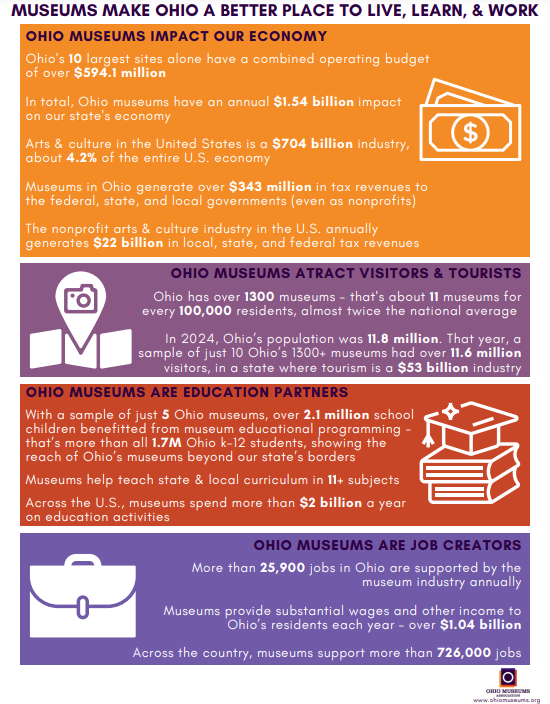As Museum Advocacy Day approaches, and in light of a potential funding crisis on the horizon, we find ourselves thinking about the art of persuasion and how successful museum advocacy and fundraising go hand in hand. The most effective messages work for both.
Today, Museum 411 explores how your museum can tailor its advocacy and fundraising efforts to resonate at city and state levels.
As we discussed last week, there’s much to be said for the numbers, the hard data. While national impact figures have their place, state and local advocacy requires a slightly more refined approach.
Tailoring your message
Legislators care most about their own districts and states, so use statewide data (or get even more granular) whenever you can.
Find out the answers to questions like:
- What is your annual economic contribution to the local economy?
- How many visitors do you bring in, and how many are from out of town?
- How many students do you welcome in each year?
- How many jobs does your museum sustain?
The culture team at Bloomberg Associates notes, “Cities are increasingly using data to help shape policy and identify service gaps, but data about arts and culture is often met with skepticism.” To help figure out which metrics are meaningful, you might look at the free guide and resources here: Arts Data in the Public Sector: Strategies for Local Arts Agencies.
Representing museum impact through hard data sometimes feels like it’s missing the point of museums, but you’ll be excluded from policymaking if you can’t provide the numbers.
A catchy figure worth calculating: “For every $1 spent on admission, $x goes back to our city’s economy.”
Once you have your data, pair it with personal stories from community members — teachers sharing how your exhibits inspire their students, local business owners who can credit your museum events for increased foot traffic. You know the power and value of storytelling better than anyone.
That said, sentimentality alone won’t get results. But data + emotional hooks can be memorable (and persuasive). And the emotional hooks are a good way to engender local pride, which should very much be part of your strategy.
It’s also important to think about the other party, be it legislator, municipal leader, or potential donor, as someone who wants to excel in their role and look good. What can they do for you that they can then “brag” about? Think of ways to frame your asks in terms of impact areas that matter to them and to their work. A little finesse is a good thing here.
One detail that’s simple but often overlooked: Museums are your priority, but they’re one of hundreds of issues crossing a representative’s desk each year. What you may see as common knowledge about museum impact could be illuminating information to someone working in the government. The same principle applies to donors at any scale.
A few basic examples from which to build talking points:
- Museums provide direct employment (curators, educators, archivists) and support indirect jobs (tourism, hospitality, retail).
- Does your museum provide STEM education? Emphasize how those programs align with your state’s STEM education initiatives.
- Do you offer programs for older adults or wellness programs? Can you link to a return on investment there?
Strategic tools and resources
The American Alliance of Museums has a ton of good resources for advocacy from all angles.
Have you made use of the Local and Regional Findings in Arts & Economic Prosperity 6 (AEP6), put together by Americans for the Arts?
What about State-Level Estimates of the Arts’ Economic Value and Employment (2017-2022) from the National Endowment for the Arts?
It seems we can’t go one week without talking about collaboration. In terms of strategy, a united voice representing multiple cultural institutions can wield significantly more influence when advocating for funding or policy changes. This is the ethos of Museum Advocacy Day, of course.
Our friends at Ohio Museums Association are a great example of statewide collaboration done well, organizing collective advocacy initiatives and still providing resources for individual efforts. Check out their advocacy resource page for a blank Economic Impact Form and Educational Impact Form if you need them. Come to meetings armed with copies of your customized reports. Here’s an example of an impact statement you might use as a guide.

Further recommended resources:
Small Museum Advocacy 101
Small Museums Guide to Successful Fundraising Campaigns
A Museum-Specific AMA on Reddit About Government Advocacy
Playing the game
As you’ve no doubt read before, possibly on this very site, advocacy and fundraising are about relationship-building.
Asking for money is an awkward proposition. But change your mindset a bit by telling yourself, “I’m not asking for money; I’m making a case for why cultural investment benefits everyone.” You’re proving the value of cultural investment.
How can you build those relationships? Routinely check in with people in power. Set reminders to do so! Schedule in-person visits. Personally invite government officials, city leaders, and donors to exhibitions, programs, or group tours — not just fundraising events — to share firsthand how your work benefits the community.
Other tips:
- Your community can help with the legwork here. Encourage grassroots advocacy from your supporters, perhaps through letter-writing or attendance at city council meetings if it makes sense. Start a hashtag and see what kind of traction you can get on social media. Legislators prioritize issues that have visible public support, so hearing from constituents creates good pressure. Plus, people who advocate for your museum are also likely to donate.
- Make yourself known. Cordially offer your services as a resource for policymakers who need data or perspectives on cultural investment. After all, you have much to offer.
- Involve your board members! Many of these folks have connections to corporate sponsors and policymakers and can be powerful allies in these arenas.
- Always be mindful of the advocacy/fundraising connection:
- Include advocacy impact in your fundraising reports.
- Encourage corporate sponsors to co-sign advocacy letters or participate in legislative meetings.
The secret bonus of advocacy: Foundations and major donors will sometimes favor museums that actively advocate for the cultural sector. Being engaged pays off across the board.





